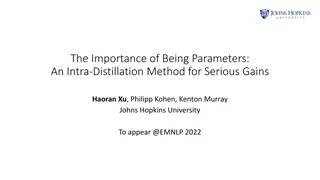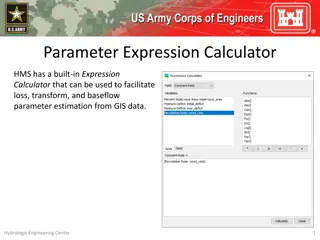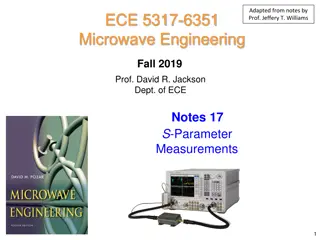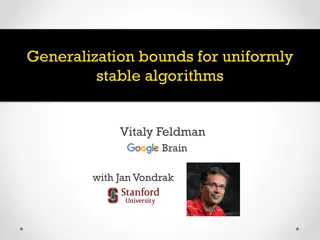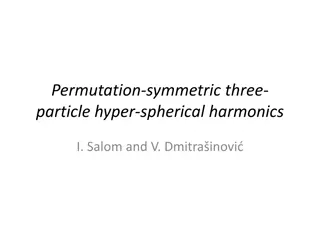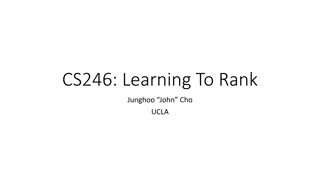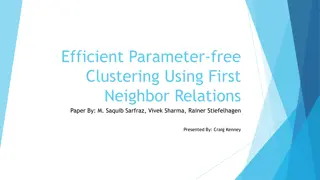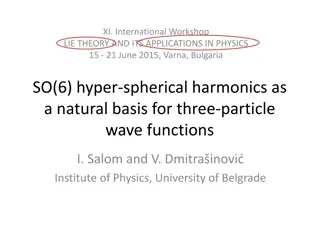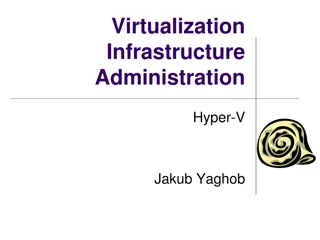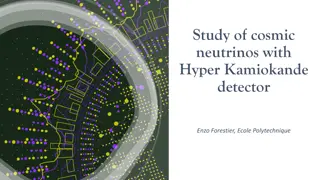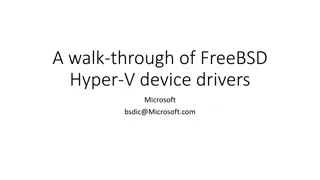Exploring Metalearning and Hyper-Parameter Optimization in Machine Learning Research
The evolution of metalearning in the machine learning community is traced from the initial workshop in 1998 to recent developments in hyper-parameter optimization. Challenges in classifier selection and the validity of hyper-parameter optimization claims are discussed, urging the exploration of specific cases where optimization holds true. Researchers are prompted to validate these claims through metalearning approaches to enhance predictive accuracy.
- Metalearning
- Hyper-parameter Optimization
- Machine Learning Research
- Classifier Selection
- Validity Claims
Download Presentation

Please find below an Image/Link to download the presentation.
The content on the website is provided AS IS for your information and personal use only. It may not be sold, licensed, or shared on other websites without obtaining consent from the author. Download presentation by click this link. If you encounter any issues during the download, it is possible that the publisher has removed the file from their server.
E N D
Presentation Transcript
First Workshop on Metalearning in 1998 at ECML 8 papers (2 by organizers!) About 20 attendees EU-heavy Then ICML 1999, ECML 2000, ECML 2001, etc. MLJ SI on Metalearning, 2004 First Workshops on AutoML/Metalearning in 2014 at ECAI/2015 at ECML Look at today! 29 accepted papers / ~100 attendees Wide range of origins
Informing the Use of Hyper- Parameter Optimization Through Metalearning Parker Ridd, Samantha Sanders, Christophe Giraud-Carrier
Many Metalearning Approaches Assume that for all base classification learning algorithms, the parameter setting is fixed to some default Consequently: The problem of metalearning for classifier selection is greatly simplified Such approaches attract at best serious criticism, and at worst, plain dismissal from the community WHY?
Hyper-parameter Optimization Claim Hyper-parameter optimization (HPO) has a significant impact (for the better) on the predictive accuracy of classification learning algorithms
Consequently Two possible approaches: Two-stage metalearning Solve restricted version of the problem (i.e., with default parameter setting) Optimize hyper-parameters for selected algorithm Unrestricted metalearning Select both the classifier and its hyper-parameters at once Two-stage metalearning may be sub-optimal Unrestricted metalearning is expensive
Is This Reasonable? Almost everybody believes that the claim of hyper-parameter optimization holds Almost nobody has attempted to verify its validity either theoretically or empirically Do you see the problem? What if it does not hold in general? What if it only holds in specific cases? Shouldn t we find out what those cases are? We use metalearning to address these questions
There Is One Study Sun and Pfahringer considered 466 datasets and reported on the percentage of improvement of the best AUC score among 20 classification algorithms after parameter optimization (using PSO) over the best AUC score among the same classification algorithms with their default parameter settings.
Impact of HPO by Increasing Value of Improvement Impact highly variable across datasets For 19% of the datasets, HPO offers no improvement at all Improvement does not exceed 5% for 80% of the datasets Linear relationship (slope=12) from 0% to 5%
Why This Matters HPO does not improve performance uniformly across datasets For many datasets, very little improvement and thus computational overkill For some datasets, significant difference and thus beneficial Important because HPO is expensive Auto-Weka took on average 13 hours per dataset in the work of Thornton et al Much of this is wasted if significant improvement is only observed in a small fraction of cases (possibly none depending on the datasets)
Metalearning Impact of HPO Take 1 Data preparation Remove small datasets (<= 100) Extract meta-features for each dataset (Reif s tool) Meta-feature selection (manual and CFS) Label datasets (0 for no advantage and 1 for likely performance advantage) Select metalearner comprehensibility and preliminary results J48
Threshold = 1.5 Default: A=62%, P=62%, R=100% Feature selection + J48 joint entropy, NB, NN1 A=79%, P=81%, R=86% NN1 root of induced tree Good recall on test data Metamodel claims 83% of the total performance improvement available at the base level
Threshold = 2.5 Default: A=50%, P=50%, R=100% Feature selection + J48 kurtosis prep, normalized attribute entropy, joint entropy, NB, NN1 A=75%, P=71%, R=84% NN1 root of induced tree Good recall on test data Metamodel claims 74% of the total performance improvement available at the base level
An Unexpected Finding In virtually all metamodels, NN1 is the root of the induced tree Linear regression of the actual percentage of improvement on the meta-features also assigns large weight to NN1 Confirms Reif et al s results that landmarkers are generally better than other meta-features, especially NN1 and NB NN1 is very efficient, hence the determination could be very fast
Study 1 Suggests Two-stage approach may indeed be adequate, but the correct one consists of: Determining whether HPO is likely to yield improvement If so, solving the unrestricted version of the problem Limitations: Aggregate analysis: best default vs. best HPO All datasets binarized No test of significance Cost of HPO ignored
Metalearning Impact of HPO Take 2 Repeat Study 1 on per-algorithm basis: When HPO improves algorithm A How long HPO takes to exceed default performance How much HPO improves A within budget T
Experiment Components Optimization Method Genetic Algorithm (24 hours to optimize) Performance Measure Multi-Class AUC Datasets 229 (raw) datasets from OpenML Algorithms MLP, SVM, Decision Tree (scikit-learn)
Hyper-parameters Decision Tree (8) split criterion, max depth, max leaves, etc. MLP (18) Hidden layer, learning rate, momentum, etc. SVM (5) C, kernel, gamma, etc.
Data Collection For default and HPO experiments: 30 starts 3 algs 229 datasets = 20,610 data points Stop: Perfect MAUC or 24 hrs Time (sec.) Generation Parameters Fitness (MAUC) 13.37 1 split=entropy ... 0.8684 34.45 2 split=gini ... 0.8743 63.79 3 split=gini ... 0.8748 Label: 95% confidence intervals for default and HPO No overlap -> optimize, otherwise no Extract meta-features, metalearn
When HPO Helps TL;DR -- Almost always
MAUC Confidence Interval Gap 7,2,2 Default yields perfect MAUC
Since Improvement Is Most Likely: How Much Does HPO Helps
Experiment Components Metalearner MLP Performance Metrics Correlation Coefficient, MAE, RMSE Dataset Meta-feature dataset (PCA) To Predict Improvement in MAUC for DT, SVM, MLP
Results Meta-feature Dataset Decision Tree Correlation Coefficient 0.56 Mean Absolute Error 0.06 Root Mean Squared Error 0.11 SVM 0.54 0.17 0.26 MLP 0.47 0.15 0.23
Predicting How Long it Will Take to Beat Default Settings
Experiment Components Metalearner Decision Tree Performance Metrics Accuracy, Precision, Recall, ROC Area Dataset Meta-feature dataset To Predict Will it take more or less than X minutes to exceed performance of default hyper-parameters?
MLP Dataset Results Runtime Cutoff Baseline Acc. (prediction) Accuracy Precision Recall ROC Area 30 Min 56% 90% 0.91 0.87 0.91 1 Hour 57% 90% 0.91 0.92 0.91 3 Hours 68% 88% 0.93 0.90 0.90 Precision: Instances labeled as needing less than T to reach default hyper- parameter benchmark, actually need less than T. Recall: Instances needing less than T to reach the default hyper-parameter benchmark are actually labeled as such.
SVM Dataset Results Runtime Cutoff Baseline Acc. (prediction) Accuracy Precision Recall ROC Area 30 Min 58% 88% 0.86 0.84 0.86 1 Hour 50% 81% 0.82 0.80 0.78 3 Hours 77% 73% 0.81 0.85 0.58
Decision Tree Dataset Results Runtime Cutoff Baseline Acc. (prediction) Accuracy Precision Recall ROC Area 10 Sec 52% 89% 0.90 0.87 0.91 60 Sec 68% 91% 0.94 0.92 0.88 30 Min 97% 97% 0.98 0.98 0.68
Our (Not So) Unexpected Friend Again For all metamodels predicting improvement within budget, NN1_time is the root of the induced tree Confirms early results Warrants further investigation into NN1 and other landmarkers
Study 2 Suggests Statistically significant improvement of HPO over default can be achieved in almost all cases Study 1? maybe more datasets had perfect performance with default (446/229), binarization, etc. It seems we can: Predict with some degree of accuracy, how much improvement can be expected Predict if default hyper-parameter performance can be improved upon within a given time budget
Parting Thoughts Directly related Repeat with more learning algorithms Metamodels vs. joint optimization More broadly Need continued work on metalearning (WSs, etc.) Thankless! MLJ SI on Metalearning Jan 2018 DARPA D3M Project



